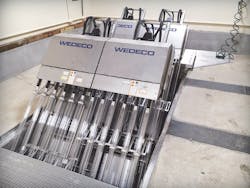Minnesota City Upgrades Water Treatment With UV Disinfection
About the author:
Kevin Flis is business development manager for Xylem. Flis can be reached at [email protected].
To accommodate a growing population, officials in the small Minnesota city of St. Francis sought to replace a 1970s-era wastewater treatment facility. Ensuring future sustainability and allowing for expansion were top priorities for the city.
Although St. Francis, located in Anoka and Isanti counties, has a population of only 7,218, it had big ideas when it came to the future of its wastewater treatment system. Those big ideas came to fruition starting in 2015 when the city began building a new treatment facility at its existing wastewater treatment plant site. Although it was upgraded in 2000, the upgrade did not address existing and future regulations regarding ammonia and phosphorus. The plant also needed to be expanded to provide additional capacity for the city’s growth. St. Francis completed construction of the new $20 million water treatment facility in 2018.
Non-Potable Water Reuse System
The plant can process up to 2 million gallons of wastewater per day. The treatment process includes aeration, detention, tertiary filtration and both effluent and reclaimed water pumping facilities. The project also includes a new lift station and elimination of the facility’s discharge outfall to the Rum River. In addition to the treatment plant, the city’s Department of Public Works is responsible for a sewer system consisting of about 19.5 miles of sewer main, 655 manholes and nine lift stations.
The uncertainty of future regulatory limits caused the city to begin looking for ways to improve future sustainability along with greater potential to expand its capacity while creating a greener facility. Working with consulting engineer Bolton & Menk, the city pursued non-potable water reuse as a method by which they could meet these priorities and provide a long-term economic benefit to the community.
Filtration was already in place due to effluent phosphorus requirements imposed to protect the Seelye Brook and Rum River. Additional monitoring and disinfection capacity were all that were necessary to achieve the prescribed ultraviolet (UV) dose of 100 milli Joules per square centimeter (mJ/cm2) to achieve the 5-log virus inactivation and the less than 2.2 total coliform counts on a seven-day geometric mean. The reuse water is immediately available for site irrigation at the wastewater treatment facility and the nearby public works facility. The city can pursue future expansion of reuse water to community parks, golf courses and, ultimately, residential lawns.
Ease of Maintenance a Priority
When selecting a UV system for non-potable reuse, St. Francis placed significant emphasis on ease of maintenance. Relying on the expertise of some city staff that had previous experience with horizontal UV systems that included ballasts in the modules, the city knew that UV system design features that reduced time-consuming maintenance was critical. For this reason and several others, the city selected Xylem’s Wedeco Duron UV system. The Duron UV system, which meets the standards required by Title 22 of the California Code of Regulations for recycled water, is an inclined UV system with the ease of maintenance the city required.
Central to the design of the Duron UV system is how easily and efficiently the system is maintained and serviced. At an inclined angle, the lamps are easy to reach and replace without having to remove the equipment from the channel. Safe and ergonomic maintenance is ensured by dry-top UV lamp access and a compact, integrated lifting mechanism. The ballasts are in separate cabinets that make them easy to access for simple maintenance anytime.
Finally, the UV system is equipped with an automatic lifting system for ease of maintenance, off-season storage and improved access to all related equipment.
Long-Term Energy Efficiency
The UV system combines intelligent control with advanced UV lamp and ballast technology, ensuring the correct dose and reducing energy consumption. Due to the inclined lamp arrangement and the 600 watt Ecoray UV lamps used in the system, total UV lamp count can be significantly reduced without compromising performance. The all-in-one system also requires less space and is simple to operate.
The UV system designed for the city of St. Francis features five UV banks in a single channel with two UV modules per bank and 12 lamps per module, for a total of 120 lamps. Arranging the system this way only required one ballast cabinet for every pair of UV banks.
The treatment system also features OptiDose, a sensor-based, real-time dose control that monitors operating conditions including flow, UV transmittance (UVT) and UV intensity. With control logic, OptiDose adjusts the energy consumption to the minimum requirement for meeting dosing requirements.
Additional system features include:
- PLC controls — an operator-friendly UV system control with SCADA communication; and
- OptiWipe system — a chemical-free, automatic, mechanical wiping system equipped with wipers that consist of unique polytetrafluoroethylene and fluoroelastomer rings, which are effective even in waters with high fouling potential.
Staying Ahead of the Curve
With the help of Xylem and the low-maintenance Wedeco Duron UV system, St. Francis was able to realize its goals of meeting new regulatory limits and efficiently expanding capacity.
Although sized to produce 2 mgd of wastewater for reuse, the new system is consistently operating at 300,000 gallons per day. The new plant is proving itself to be a greener facility, as highly treated wastewater from the UV system is used for site irrigation now and is available for other non-potable applications for years to come.
